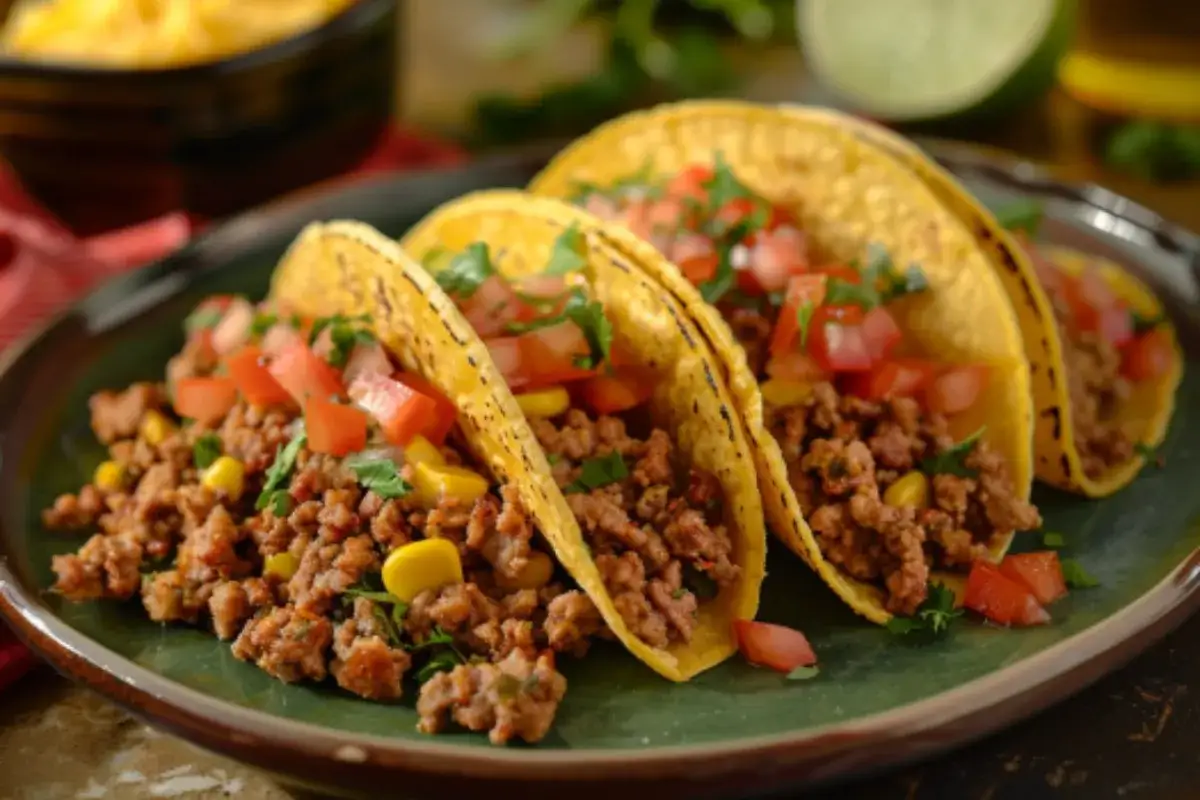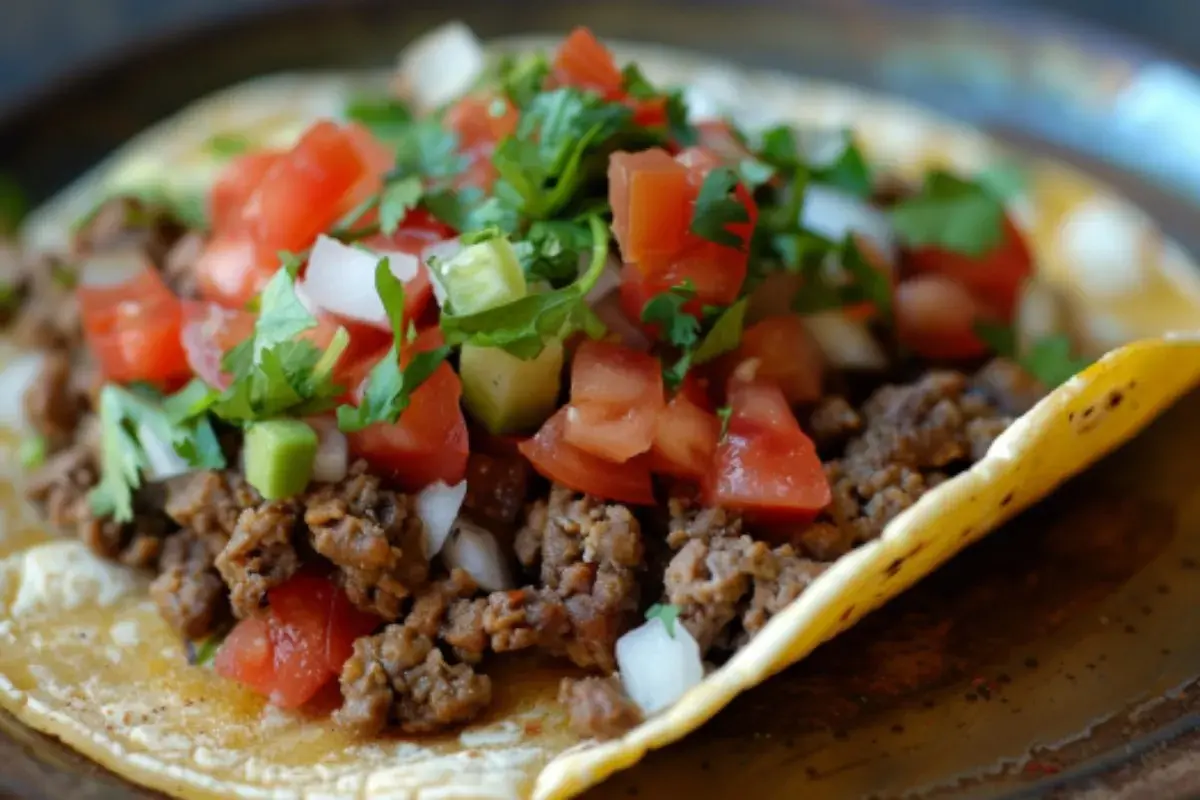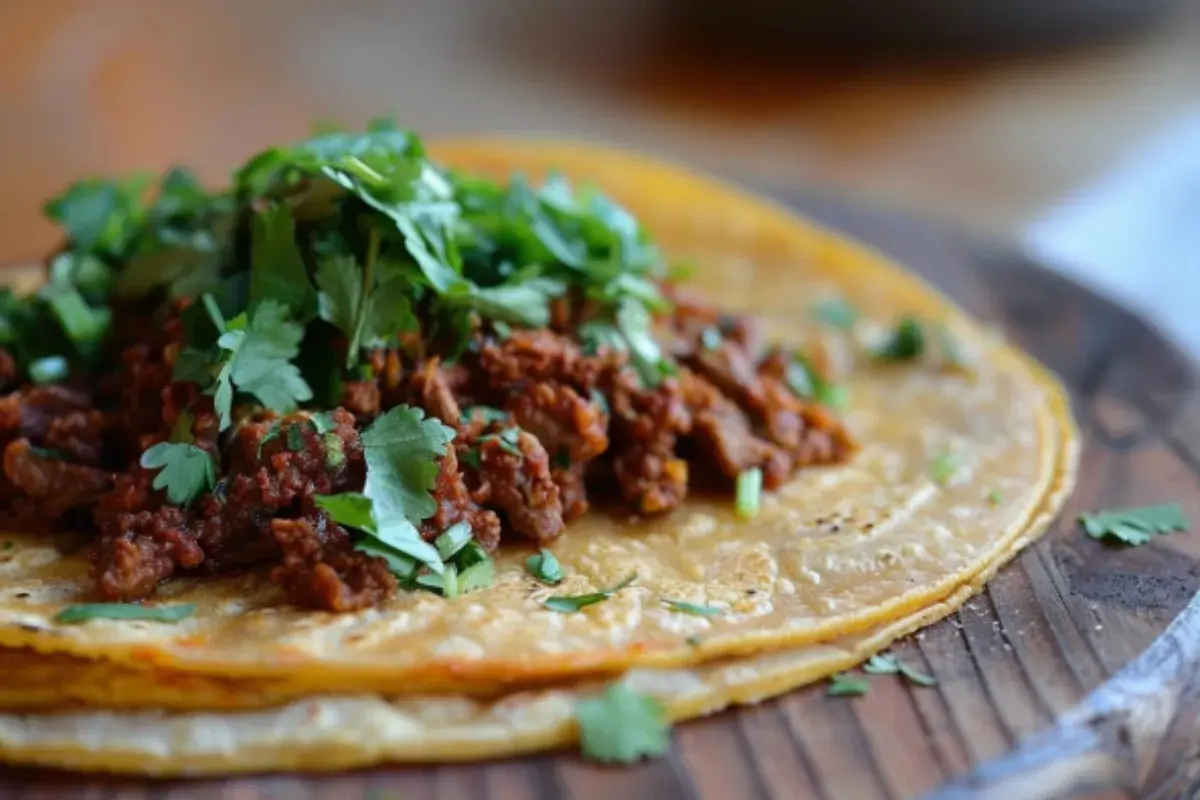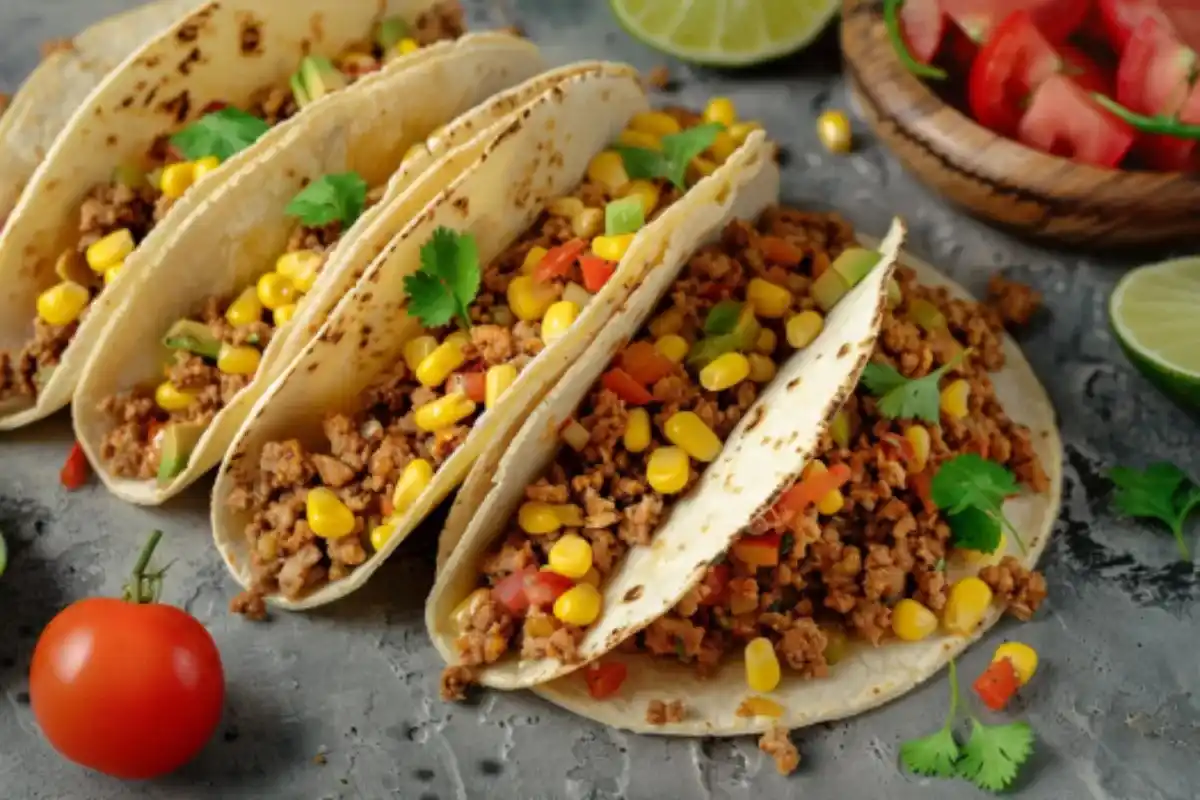Traditional taco are not just food; they are a way of life in mexico, deeply embedded in its rich culinary heritage. far from the fusion tacos that have gained popularity in recent years, traditional mexican tacos stay true to their humble roots, emphasizing simple yet flavorful ingredients that chefs have used for centuries.
Chefs can break down a traditional taco into several key elements, each playing a crucial role in delivering the taste, texture, and authenticity that define Mexican tacos. In this article, we will explore the critical components, variations, preparation methods, and cultural influences that shape this iconic dish.
Introduction to Traditional Tacos
Historians believe that indigenous Mexican cultures created tacos before the Spanish arrived. They used corn, an essential crop in Mesoamerican civilizations, to make flatbreads that could hold various fillings. These early versions of the taco were likely consumed by the Aztecs and other indigenous groups. Fast forward to today, tacos have become a global phenomenon, with numerous variations. However, it is the traditional taco, with its authentic ingredients and flavors, that remains a true representation of Mexico’s culinary identity.
At its core, a traditional taco consists of a soft corn tortilla that folds around a filling, which can include anything from grilled meats to seafood, vegetables, or even insects, depending on the region. what sets the traditional taco apart is its simplicity; chefs carefully choose each element to complement the others, creating a harmonious blend of textures and flavors.
The Importance of Corn Tortillas in What Goes in a Traditional Taco
The History and Significance of Corn Tortillas

Corn tortillas are the backbone of the traditional taco, and they have been a staple in the mexican diet for thousands of years. made from nixtamalized corn (corn soaked and cooked in an alkaline solution), these tortillas have a distinct flavor and texture that flour tortillas cannot replicate. The process of nixtamalization, which dates back to ancient Mesoamerican cultures, makes the corn more nutritious and gives the tortillas their characteristic pliability. You can even learn how to make corn tortillas from scratch to experience their authentic flavor.
In Mexico, cooks often make tortillas fresh daily, either by hand or with the help of a tortilla press. They flatten the dough, or masa, into thin discs and cook them on a comal (a flat griddle), resulting in a slightly charred exterior that enhances the flavor of the taco.
Corn vs. Flour Tortillas
While flour tortillas have gained popularity in some parts of mexico, especially in the north, corn tortillas are the traditional choice for tacos. their earthy, slightly sweet taste pairs perfectly with the bold flavors of the fillings. the texture of corn tortillas also provides a sturdier base for tacos, which is important for holding the often-juicy fillings without breaking apart.
For those who want to explore more about different types of taco shells and how they affect the overall taste of tacos, here is a guide on what taco shells are made of.
Traditional Proteins for What Goes in a Traditional Taco
The protein in a taco is arguably its most defining element. From grilled meats to slow-cooked delicacies, traditional Mexican tacos offer a wide variety of options. Each type of protein adds its own unique flavor, and cooks often select the meat based on the regional influences where the taco is prepared.
Carnitas (Slow-Cooked Pork)
One of the most popular taco fillings in central Mexico is carnitas, which translates to “little meats.” Chefs make carnitas by slow-cooking pork in its own fat until it becomes tender and juicy. The cooking process is critical, as they need to cook the pork at a low temperature for several hours to ensure that it remains moist while developing a deep, rich flavor.
After chefs slow-cook the pork, they often crisp it up before serving to add a crunchy texture that contrasts with the softness of the tortilla and the other taco ingredients. They typically garnish carnitas tacos with chopped onions, cilantro, and a squeeze of lime juice, making them a flavorful yet simple option.
Asada (Grilled Beef)
Carne asada is another classic taco filling, particularly popular in northern Mexico. Cooks marinate the beef, usually a flank or skirt steak, in a mixture of citrus juices, garlic, and spices before grilling it to perfection. The marinade helps tenderize the meat while adding bright, zesty flavors that enhance the overall taco experience.
Grilling the beef over an open flame gives it a smoky flavor that pairs beautifully with the corn tortilla. Once the meat is cooked, it is sliced thin and served with fresh toppings like salsa and guacamole.
Pollo (Grilled or Shredded Chicken)
While beef and pork are the more traditional taco fillings, pollo, or chicken, is also a common option. Cooks often grill or shred chicken and season it with a variety of spices, including cumin, paprika, and oregano. The preparation method and the region where cooks make the taco can cause the flavor of the chicken to vary widely.
For example, chefs marinate pollo asado in a citrus-based sauce and grill it, giving it a smoky, charred flavor, while cooks often simmer pollo deshebrado in a tomato-based sauce. Chicken tacos are typically lighter than beef or pork tacos and are often paired with fresh, tangy toppings like pico de gallo or salsa verde.
Barbacoa (Slow-Cooked Lamb or Beef)
Barbacoa is a traditional Mexican method of cooking meat that dates back to the indigenous peoples of Mexico. The meat, usually lamb or beef, is slow-cooked in an underground pit until it is tender and falling apart. The cooking process infuses the meat with a smoky flavor and results in a melt-in-your-mouth texture.
Barbacoa tacos are often served with simple toppings like onions, cilantro, and a squeeze of lime juice. The rich, smoky flavor of the meat makes barbacoa tacos a favorite in many regions of Mexico, especially in the central and southern parts of the country.
Lengua (Beef Tongue)
For those looking to try something a bit more adventurous, lengua, or beef tongue, serves as a traditional taco filling that many people love in various parts of Mexico. Cooks slow-cook the tongue until it becomes tender and then slice it thin before serving it in a taco. Despite its unusual source, beef tongue is incredibly tender and has a mild flavor that pairs well with bold toppings like salsa verde and pickled onions.
Fish (Pescado)
In coastal regions of Mexico, particularly in Baja California, fish tacos are a popular choice. The fish is usually grilled or fried and served with fresh, tangy toppings like slaw, crema, and lime wedges. Fish tacos are typically lighter and more refreshing than their meat-filled counterparts, making them a popular option for hot, sunny days.
For an in-depth recipe and guide to making authentic birria tacos, another popular Mexican taco style, visit this birria tacos recipe.
Salsas and Sauces: The Heart of Flavor
Salsas and sauces are essential components of a traditional taco. They provide the heat, acidity, and depth of flavor that balance the richness of the meat and the softness of the tortilla.
Salsa Verde: A Classic Addition to What Goes in a Traditional Taco
Chefs make salsa verde from tomatillos, a type of small, green tomato with a slightly tart flavor. They roast or boil the tomatillos and then blend them with garlic, onions, cilantro, and green chili peppers to create a tangy, slightly spicy salsa that complements almost any taco filling. The Salsa verde is especially popular with chicken, pork, and fish tacos.
Salsa Roja (Red Salsa)
Salsa roja is a red salsa typically made from tomatoes, onions, garlic, and dried red chilies. The ingredients are roasted or charred before being blended into a smooth sauce. This salsa has a deep, smoky flavor that pairs well with grilled meats like carne asada and barbacoa. The level of heat can vary depending on the type of chili used, but salsa roja is generally milder than salsa verde.
Guacamole
No taco is complete without a scoop of fresh guacamole. This creamy sauce is made from mashed avocado, lime juice, cilantro, and salt, and sometimes includes other ingredients like tomatoes, onions, or jalapeños. Guacamole adds a smooth, rich texture to tacos and helps balance out spicy salsas and bold flavors.
Pico de Gallo
Chefs prepare pico de gallo as a fresh salsa made from diced tomatoes, onions, cilantro, and jalapeños. Unlike other salsas, they do not blend pico de gallo, so the individual ingredients retain their texture, providing a crunchy, refreshing contrast to the soft tortilla and tender meat. Pico de gallo is a versatile topping that pairs well with almost any taco filling.
Vegetables and Herbs: The Finishing Touch
The final touches on a traditional taco are the fresh vegetables and herbs that add brightness and texture to the dish. Unlike modern tacos, which often feature a wide variety of toppings, traditional tacos keep it simple, letting the quality of the ingredients shine through.
Cilantro and Onions
Chopped cilantro and onions are the most common toppings for traditional tacos. The fresh, slightly tangy flavor of the onions complements the rich, savory meats, while the cilantro adds a burst of freshness. Together, they create a balance of flavors that enhances the overall taco experience.
Radishes
Thinly sliced radishes are often served alongside tacos, especially in central Mexico. The crunchy, peppery flavor of the radishes provides a nice contrast to the softness of the tortilla and the tenderness of the meat. They also add a bit of color to the plate, making the tacos visually appealing.
Cabbage
In coastal regions, particularly in Baja California, tacos are often topped with shredded cabbage instead of lettuce. Cabbage is heartier and holds up better to the moisture of the taco filling, providing a satisfying crunch. It is especially popular in fish tacos, where it adds a refreshing contrast to the rich, creamy sauces.
Lime Wedges
A squeeze of lime juice is the final touch on many traditional tacos. The acidity of the lime cuts through the richness of the meat and brightens the flavors of the taco. In Mexico, lime wedges are often served on the side, allowing diners to add as much or as little as they like.
Pickled Vegetables
In some regions, tacos are served with pickled vegetables, such as pickled jalapeños or pickled carrots. These tangy, spicy vegetables add a burst of flavor and a bit of heat to the taco, making them a popular accompaniment to richer, fattier meats like carnitas or barbacoa.
For a variety of creative taco topping ideas, check out this article on what to put in a taco shell.
Cooking Techniques for Traditional Tacos

The preparation of the taco filling is just as important as the ingredients themselves. Traditional tacos often use slow-cooking or grilling techniques to develop deep, complex flavors.
Grilling (Asada)
Grilling is one of the most common cooking methods for taco fillings like carne asada. The beef is marinated in a mixture of citrus juices, garlic, and spices before being seared over an open flame. The high heat of the grill caramelizes the exterior of the meat, creating a smoky, charred flavor that is essential for authentic carne asada tacos.
Slow-Cooking (Barbacoa, Carnitas)
For tougher cuts of meat, like pork shoulder or lamb, slow-cooking is the preferred method. The meat is cooked at a low temperature for several hours, either in its own fat (for carnitas) or in an underground pit (for barbacoa). The slow-cooking process breaks down the tough connective tissues in the meat, resulting in a tender, juicy filling that falls apart with each bite.
Frying (Fish Tacos, Tacos Dorados)
In Baja California, fish tacos are often made by lightly battering and frying the fish before serving it in a taco. The frying process gives the fish a crispy exterior while keeping the interior moist and tender. Tacos dorados, or “golden tacos,” are another popular option, where the entire taco is fried until crispy.
Heating Tortillas
The tortillas for traditional tacos are usually heated on a comal, a flat griddle that is used in Mexican cooking. The tortillas are lightly toasted on each side until they develop a slight char. This step is essential for bringing out the flavor of the corn tortilla and making it pliable enough to fold around the filling.
Popular Variations of Traditional Tacos
While the basic components of a traditional taco remain the same, there are countless regional variations across Mexico. Each region has its own unique ingredients and preparation methods that give its tacos a distinct flavor.
Tacos al Pastor
Originating in Mexico City, tacos al pastor are made with pork marinated in a mixture of chilies, spices, and pineapple, then cooked on a vertical spit, similar to shawarma. Cooks thinly slice the pork and serve it on a corn tortilla with onions, cilantro, and a piece of grilled pineapple. The combination of sweet, spicy, and savory flavors makes tacos al pastor one of the most popular types of tacos in Mexico.
Tacos de Pescado (Fish Tacos)
In Baja California, fish tacos are a staple. The fish is usually grilled or fried and served with a tangy slaw, crema, and lime wedges. Fish tacos are typically lighter and more refreshing than meat-based tacos, making them a popular option in coastal regions. The key to a great fish taco is using fresh, high-quality fish and simple, flavorful toppings that complement the delicate flavor of the fish.
Tacos de Canasta (Basket Tacos)
Tacos de canasta, or “basket tacos,” are a popular street food in central Mexico. Cooks fill the tacos with ingredients like potatoes, beans, or chicharrón (fried pork skin). Afterward, they steam them in a basket, which keeps the tacos warm and moist. They typically serve these tacos with salsa and pickled vegetables, making them a simple yet satisfying option.
Tacos de Barbacoa
As mentioned earlier, barbacoa is a method of slow-cooking meat, usually lamb or beef, in an underground pit. The result is a tender, flavorful filling that is often served with simple toppings like onions, cilantro, and lime juice. Barbacoa tacos are especially popular in the central and southern regions of Mexico. Furthermore, the tradition of pit-cooking in these areas dates back to ancient times, highlighting its cultural importance.
Tacos de Lengua (Beef Tongue)
Lengua, or beef tongue, is a popular taco filling in many parts of Mexico. The tongue is slow-cooked until tender, then sliced thin and served in a taco with onions, cilantro, and salsa verde. Despite its unusual source, beef tongue has a mild, rich flavor that makes it a favorite among taco aficionados.
Regional Influences on Tacos
Mexico is a diverse country with a wide range of climates, cultures, and culinary traditions. As a result, tacos vary significantly from one region to another. Understanding these regional influences can provide a deeper appreciation for the diversity of traditional Mexican tacos.
Northern Mexico
In the northern states of Mexico, cooks often make tacos with flour tortillas instead of corn, reflecting the region’s proximity to the United States and the availability of wheat. The most popular taco fillings in this region include carne asada, grilled chicken, and beef barbacoa. Tacos in northern Mexico tend to be heartier and more substantial, often served with a variety of toppings like guacamole, cheese, and salsa.
Central Mexico
The central region of mexico, including mexico city, is home to some of the most iconic taco styles, including tacos al pastor and tacos de canasta. this region boasts a vibrant street food culture, with taco vendors offering a wide variety of fillings, from grilled meats to vegetarian options like huitlacoche (corn fungus) and nopales (cactus). The emphasis in central Mexico is on bold, vibrant flavors, with plenty of fresh herbs and spicy salsas.
Southern Mexico
in the southern states of mexico, including oaxaca and yucatán, cooks often fill tacos with more exotic ingredients like chapulines (grasshoppers), carnitas, or cochinita pibil (slow-roasted pork). the cuisine in this region heavily reflects indigenous traditions, and chefs often showcase unique flavors and cooking techniques in the tacos that are not found in other parts of the country. For example, chefs in Oaxaca often serve tacos with mole, a rich, complex sauce made from chilies, chocolate, and spices.
Coastal Regions
In coastal areas like Baja California and the Yucatán Peninsula, seafood plays a prominent role in taco fillings.
Fish tacos, shrimp tacos, and even octopus tacos are common. Additionally, they are often served with fresh, tangy toppings like slaw, lime juice, and crema.
Moreover, the flavors in coastal tacos tend to be lighter and more refreshing. This reflects the abundance of fresh seafood available in these regions.
Sourcing Authentic Ingredients for Traditional Tacos

One of the keys to making authentic traditional tacos is using high-quality, fresh ingredients. While some ingredients may be difficult to find outside of Mexico, there are alternatives. In addition, many Latin grocery stores carry the essentials, making it easier to gather what you need:
- Masa harina for making corn tortillas from scratch.
- Mexican cheeses like cotija, queso fresco, and Oaxacan cheese.
- Dried chilies like ancho, guajillo, and pasilla for making salsas.
- Fresh herbs like cilantro, Mexican oregano, and epazote.
For those who don’t have access to a Latin grocery store, there are other options available. Furthermore, plenty of online retailers specialize in Mexican ingredients, making it easier to find what you need. Using authentic ingredients is essential for achieving the deep, complex flavors that make traditional tacos so special.
Frequently Asked Questions
1. What are the key ingredients in a traditional taco?
A traditional taco includes a soft corn tortilla, a simple but flavorful protein (such as pork, beef, or chicken), and fresh toppings like cilantro, onions, and salsa.
2. Are corn or flour tortillas more traditional for tacos?
Corn tortillas are considered more traditional for tacos, especially in central and southern Mexico. Flour tortillas are more common in the northern regions of the country.
3. What types of meat are commonly used in traditional tacos?
Popular meats for traditional tacos include carnitas (slow-cooked pork), carne asada (grilled beef), barbacoa (slow-cooked beef or lamb), and pollo (chicken). In coastal regions, fish tacos are also popular.
4. What salsas are typically served with traditional tacos?
Common salsas include salsa verde (green salsa made from tomatillos) and salsa roja (red salsa made from tomatoes and chilies). Both add flavor and heat to the tacos.
5. What are the most popular toppings for traditional tacos?
Traditional taco toppings are usually simple and include chopped cilantro, diced onions, lime wedges, and sometimes guacamole or crema.
Conclusion
Traditional tacos are a true celebration of Mexican cuisine. With their simple yet flavorful ingredients, they showcase the importance of balance and harmony in food. From the soft, slightly charred corn tortillas to the tender, slow-cooked meats, each element is carefully selected. Moreover, chefs ensure that every component of a traditional taco complements the others perfectly, including the bright, fresh toppings.
Whether you’re grilling up carne asada, slow-cooking barbacoa, or frying fish for tacos de pescado, it’s an enjoyable process. Furthermore, making traditional tacos at home is a rewarding experience that connects you with authentic flavors. Additionally, it offers a great way to enjoy authentic flavors right from your own kitchen. Moreover, it allows you to connect with the rich culinary traditions of Mexico.
So, the next time you’re in the mood for tacos, skip the fusion varieties. Instead, try making traditional tacos from scratch; you won’t be disappointed!
For more delicious and authentic taco recipes, check out this comprehensive ultimate guide to taco recipes.

